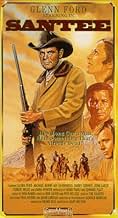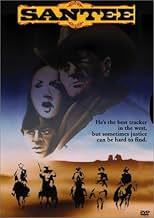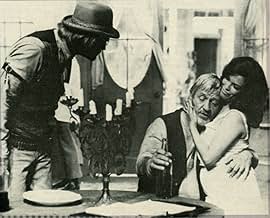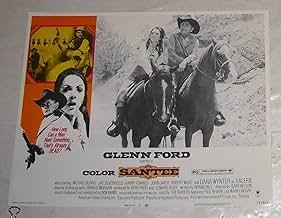अपनी भाषा में प्लॉट जोड़ेंA bounty hunter takes in the son of a man he killed.A bounty hunter takes in the son of a man he killed.A bounty hunter takes in the son of a man he killed.
Robert J. Wilke
- Deaks
- (as Robert Wilke)
फ़ीचर्ड समीक्षाएं
Glenn Ford who was associated with some of the best westerns ever made has his last starring role in the genre in Santee. Although he would do more westerns up to almost the end of his career, he would no longer be the leading man/action hero in any of them.
Ford was 57 when he made Santee and even in this one he's transitioning to be a father figure, much the same way John Wayne was in films like Big Jake, Rio Lobo, and The Cowboys.
Unfortunately Santee takes it's plot from a combination of Henry Fonda's The Tin Star and Robert Mitchum's Young Billy Young. Ford is a former lawman, turned bounty hunter who decides that marshaling doesn't give him quite the latitude he needs to deal with bad guys. It also doesn't pay as well. But having his son shot down by John Larch and his gang was enough to turn him bitter.
He's also forced to kill Robert J. Wilkie another outlaw who has a son in Michael Burns. But he takes Burns into his home. Truth be told there wasn't much attachment there anyway, Burns hardly knew him.
Jay Silverheels has the best part in the film as Ford's loquacious ranch foreman. I do believe he had more dialog here than in over 200 episodes of The Lone Ranger. Dana Wynter has a few scenes as Ford's wife and makes them count.
But Santee is just a tired rehash of a pair of better films. Glenn Ford fans will like it though.
Ford was 57 when he made Santee and even in this one he's transitioning to be a father figure, much the same way John Wayne was in films like Big Jake, Rio Lobo, and The Cowboys.
Unfortunately Santee takes it's plot from a combination of Henry Fonda's The Tin Star and Robert Mitchum's Young Billy Young. Ford is a former lawman, turned bounty hunter who decides that marshaling doesn't give him quite the latitude he needs to deal with bad guys. It also doesn't pay as well. But having his son shot down by John Larch and his gang was enough to turn him bitter.
He's also forced to kill Robert J. Wilkie another outlaw who has a son in Michael Burns. But he takes Burns into his home. Truth be told there wasn't much attachment there anyway, Burns hardly knew him.
Jay Silverheels has the best part in the film as Ford's loquacious ranch foreman. I do believe he had more dialog here than in over 200 episodes of The Lone Ranger. Dana Wynter has a few scenes as Ford's wife and makes them count.
But Santee is just a tired rehash of a pair of better films. Glenn Ford fans will like it though.
According to articles Ford refused to play a criminal after 3-10 to Yuma because he worried about his imagine. I can't fault his acting although he was overweight and and had difficulty getting on and off his horse several times
He always had a amazing unique voice that had several ranges to it. The plot kept me interested and the scenery was amazing. Can't fault the actors for the problems with the film and camera. Certainly hated the ending. Ford carried his role well as substitute father, hunter, friend, husband and rancher. Burns, Silverheels and the rest of supporting cast does not disappoint. Lot to fit in a movie and actually could have been 3 with a little creative writing. Would recommend to all western fans. Found the movie free on YouTube.
Another movie from the Mill Creek 200 cult cinema box set.
Pretty good western about a bounty hunter who takes in the boy of the man he killed. Teaches him the ropes and becomes like a father to him.
I liked this, not to big on westerns but very well done. Glen Ford is great as Santee. All around good movie.
Pretty good western about a bounty hunter who takes in the boy of the man he killed. Teaches him the ropes and becomes like a father to him.
I liked this, not to big on westerns but very well done. Glen Ford is great as Santee. All around good movie.
Santee is directed by Gary Nelson and written by Brand Bell. It stars Glenn Ford, Michael Burns, Dana Wynter and Jay Silverheels. Music is scored by Don Rand and photography is by Donald Morgan. Plot finds Ford as seasoned bounty hunter Santee, who after killing the outlaw father of young Jody Deaks (Burns), takes him under his wing at his Three Arrows Ranch. With both of them nursing loses in their lives, they both come to be great for each other, but just as harmony is abundant at the ranch, news comes that the outlaw gang responsible for Santee's pain is back in town.
No country for empty pockets and a flat stomach.
Primarily shot on location in Santa Fe, New Mexico, Santee is notable for a couple of things. Firstly it was the last time that Western legend Ford would play a lead role in the genre, secondly is that it was filmed on video tape. Some debate exists as to if it was the first film to be shot that way, but certainly the research suggests it was definitely the first Western. Santee is a strange film in many ways, for sure as a film it's not a great lead role send off for Ford, but he is actually very good in it. The story is a good one from Bell, full of emotional worth and maintaining interest throughout, while there's plenty of action and blood shed within the plot. The dialogue, too, often has some intelligence about it. But it's so poorly put together it becomes a frustrating watching experience.
The video tape filming doesn't work, the colour is often dull and the night interiors are lifeless. While a couple of close ups appear to suddenly become pan and scan! Other problem comes with there being no truly great villain to underpin the destinies of Santee and Jody Deaks. The Banner (John Larch) gang exist, get a couple of small scenes, but that's about it until the bloody finale. The cast around Ford are OK, Wynter doesn't quite look right for a ranch gal lover, but makes a mark as a loyal wife and surrogate mother. Burns has the youthful naivety just right, but isn't helped by the screenplay having him become a killing man too quickly, and Silverheels turns in a good one as the wise ranch hand at Three Arrows. The film is very 70s in look and feel, something that can take you out of the period setting, more so with Rand's foot tapping music accompaniment. Bonus, though, on the music front, is the feature song in the picture, "Jody," that is song by Paul Revere and The Raiders, it's a beautiful ballad and carries with it the requisite emotional heft.
An enjoyable Western with one or two tricks up its sleeve, but the problems are evident and stop it from being a must see for anyone other than Western and Glenn Ford purists. 6/10
No country for empty pockets and a flat stomach.
Primarily shot on location in Santa Fe, New Mexico, Santee is notable for a couple of things. Firstly it was the last time that Western legend Ford would play a lead role in the genre, secondly is that it was filmed on video tape. Some debate exists as to if it was the first film to be shot that way, but certainly the research suggests it was definitely the first Western. Santee is a strange film in many ways, for sure as a film it's not a great lead role send off for Ford, but he is actually very good in it. The story is a good one from Bell, full of emotional worth and maintaining interest throughout, while there's plenty of action and blood shed within the plot. The dialogue, too, often has some intelligence about it. But it's so poorly put together it becomes a frustrating watching experience.
The video tape filming doesn't work, the colour is often dull and the night interiors are lifeless. While a couple of close ups appear to suddenly become pan and scan! Other problem comes with there being no truly great villain to underpin the destinies of Santee and Jody Deaks. The Banner (John Larch) gang exist, get a couple of small scenes, but that's about it until the bloody finale. The cast around Ford are OK, Wynter doesn't quite look right for a ranch gal lover, but makes a mark as a loyal wife and surrogate mother. Burns has the youthful naivety just right, but isn't helped by the screenplay having him become a killing man too quickly, and Silverheels turns in a good one as the wise ranch hand at Three Arrows. The film is very 70s in look and feel, something that can take you out of the period setting, more so with Rand's foot tapping music accompaniment. Bonus, though, on the music front, is the feature song in the picture, "Jody," that is song by Paul Revere and The Raiders, it's a beautiful ballad and carries with it the requisite emotional heft.
An enjoyable Western with one or two tricks up its sleeve, but the problems are evident and stop it from being a must see for anyone other than Western and Glenn Ford purists. 6/10
Few people remember that SANTEE was one of the very first feature films (and almost definitely the first Western) shot on videotape. Noted character actor Ed Platt, famous for his role as "The Chief" in the TV series GET SMART, reportedly invested his own money in this film, intending to champion the concept of shooting movies economically on videotape.
The process used portable Philips (aka Norelco) video cameras and primitive Ampex 2" videotape recorders, which they powered via batteries while shooting on-location the desert and in and around California and Nevada. A 1973 issue of AMERICAN
CINEMATOGRAPHER covered the work done by director of photography Don Morgan and his crew, and went in-depth on the differences between shooting on film and shooting on video. Sadly, SANTEE was a flop in theaters, and Ed Platt lost his money and died less than a year after the movie was released.
Three decades later, innovative filmmakers like Robert Rodriguez and George Lucas are using digital video gear to shoot movies. Ed Platt was definitely ahead of his time on SANTEE; sadly, he never lived to see the technology get to the point where it would work.
The process used portable Philips (aka Norelco) video cameras and primitive Ampex 2" videotape recorders, which they powered via batteries while shooting on-location the desert and in and around California and Nevada. A 1973 issue of AMERICAN
CINEMATOGRAPHER covered the work done by director of photography Don Morgan and his crew, and went in-depth on the differences between shooting on film and shooting on video. Sadly, SANTEE was a flop in theaters, and Ed Platt lost his money and died less than a year after the movie was released.
Three decades later, innovative filmmakers like Robert Rodriguez and George Lucas are using digital video gear to shoot movies. Ed Platt was definitely ahead of his time on SANTEE; sadly, he never lived to see the technology get to the point where it would work.
क्या आपको पता है
- ट्रिवियाIn 1972-73, Edward Platt ("The Chief" in Get Smart (1965)) raised enough money to produce this film, which was one of the first independent color movies shot partially on videotape. It was actually the first western to use videotape on location. Platt saw the many advantages of using videotape rather than film, and his crew shot the production with portable TV cameras (Norelco PCP-70 NTSC analog television system and the Philips PC-70 studio color camera) along with the Ampex VR-3000 two-inch portable video tape recorder). Once completed, the images were transferred to 35mm film format for it's theatrical release.
- इसके अलावा अन्य वर्जनThe UK video version was cut by 4 secs to remove a horse-fall.
- साउंडट्रैकJody
Music by Don Randi
Lyrics by Bob Silver & Pete Willcox
Performed by The Raiders, featuring Paul Revere & Mark Lindsay
टॉप पसंद
रेटिंग देने के लिए साइन-इन करें और वैयक्तिकृत सुझावों के लिए वॉचलिस्ट करें
- How long is Santee?Alexa द्वारा संचालित
विवरण
- रिलीज़ की तारीख़
- कंट्री ऑफ़ ओरिजिन
- आधिकारिक साइट
- भाषा
- इस रूप में भी जाना जाता है
- Santee - Der Einzelgänger
- फ़िल्माने की जगहें
- उत्पादन कंपनियां
- IMDbPro पर और कंपनी क्रेडिट देखें
इस पेज में योगदान दें
किसी बदलाव का सुझाव दें या अनुपलब्ध कॉन्टेंट जोड़ें




































